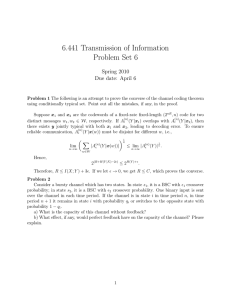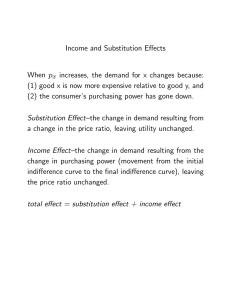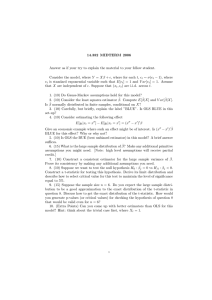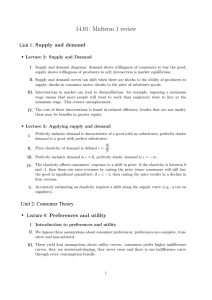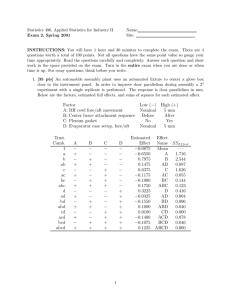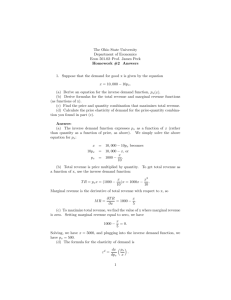Document 13568258
advertisement
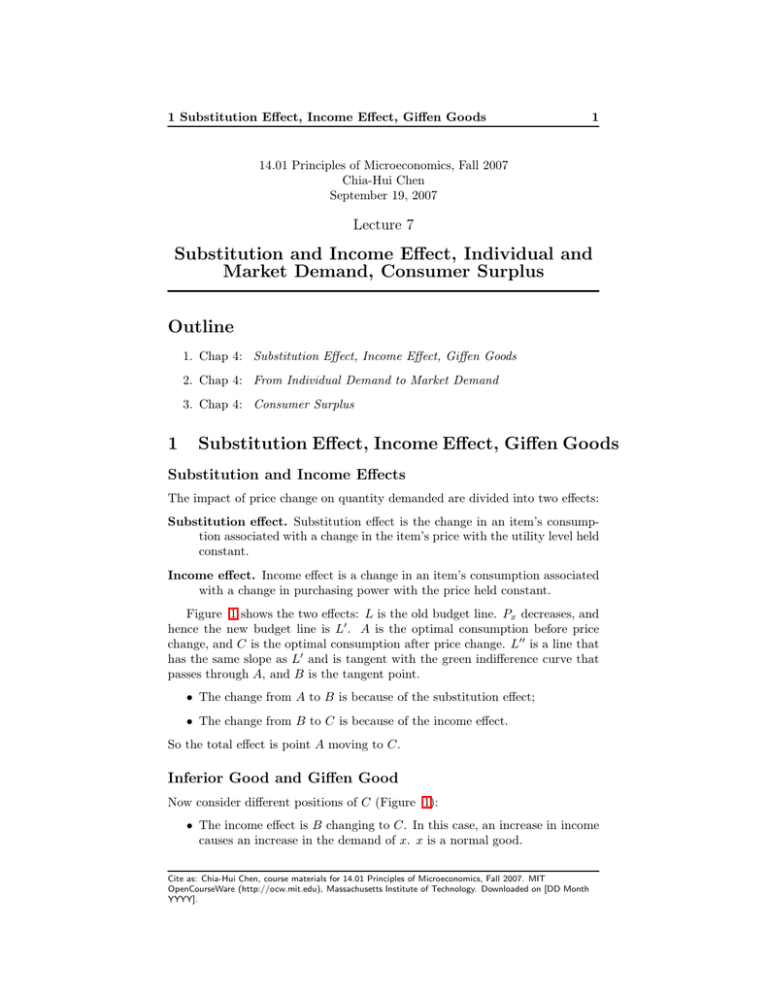
1 Substitution Effect, Income Effect, Giffen Goods 1 14.01 Principles of Microeconomics, Fall 2007 Chia-Hui Chen September 19, 2007 Lecture 7 Substitution and Income Effect, Individual and Market Demand, Consumer Surplus Outline 1. Chap 4: Substitution Effect, Income Effect, Giffen Goods 2. Chap 4: From Individual Demand to Market Demand 3. Chap 4: Consumer Surplus 1 Substitution Effect, Income Effect, Giffen Goods Substitution and Income Effects The impact of price change on quantity demanded are divided into two effects: Substitution effect. Substitution effect is the change in an item’s consump­ tion associated with a change in the item’s price with the utility level held constant. Income effect. Income effect is a change in an item’s consumption associated with a change in purchasing power with the price held constant. Figure 1 shows the two effects: L is the old budget line. Px decreases, and hence the new budget line is L′ . A is the optimal consumption before price change, and C is the optimal consumption after price change. L′′ is a line that has the same slope as L′ and is tangent with the green indifference curve that passes through A, and B is the tangent point. • The change from A to B is because of the substitution effect; • The change from B to C is because of the income effect. So the total effect is point A moving to C. Inferior Good and Giffen Good Now consider different positions of C (Figure 1): • The income effect is B changing to C. In this case, an increase in income causes an increase in the demand of x. x is a normal good. Cite as: Chia-Hui Chen, course materials for 14.01 Principles of Microeconomics, Fall 2007. MIT OpenCourseWare (http://ocw.mit.edu), Massachusetts Institute of Technology. Downloaded on [DD Month YYYY]. 1 Substitution Effect, Income Effect, Giffen Goods Figure 1: Substitution Effect and Income Effect. Cite as: Chia-Hui Chen, course materials for 14.01 Principles of Microeconomics, Fall 2007. MIT OpenCourseWare (http://ocw.mit.edu), Massachusetts Institute of Technology. Downloaded on [DD Month YYYY]. 2 1 Substitution Effect, Income Effect, Giffen Goods 3 • The income effect is B changing to C ′ or C ′′ . In these cases, an increase in income causes a decrease in the demand of x. x is an inferior good; • If the total effect is A changing to C ′′ , such that a decrease in price causes a decrease in the demand, we call x is a Giffen good. Normal good Inferior good Price increases substitution effect income effect substitution effect income effect quantity increases quantity increases quantity increases quantity decreases Table 1: Normal Good and Inferior Good In Table 1, if x is a normal good, both substitution and income effects increase its quantity; if x is an inferior good, discuss as follows: 1. substitution effect > income effect → quantity increases 2. substitution effect < income effect → quantity decreases. This unusual good is called a Giffen good. A Giffen good must be an inferior good, but an inferior good is not necessarily a Giffen good. Giffen good. Good with an upward demand curve. (Figure 2) Example (Giffen Good Example: Irish Potato Famine). People consumed lots of potato but little meat (and other food) since meat was more expensive. Price of potato rose. People had less money to consume meat, so they ate more potatoes instead of meat. An Example of Substitution Effects and Income Effects Utility function Figure 3: √ U (x, y) = x + 2 y. Parameters: Px = 1, Py = 1, I = 5. The optimal solution is: x = 4, y = 1. Cite as: Chia-Hui Chen, course materials for 14.01 Principles of Microeconomics, Fall 2007. MIT OpenCourseWare (http://ocw.mit.edu), Massachusetts Institute of Technology. Downloaded on [DD Month YYYY]. 1 Substitution Effect, Income Effect, Giffen Goods 4 6 5.5 5 4.5 P 4 3.5 3 2.5 2 1.5 1 0 0.5 1 1.5 2 Q 2.5 3 3.5 4 D Figure 2: Demand Curve of Giffen Good. i.e. the solution is at point A: (4, 1). If price of x changes to 2, Px′ = 2, then the new optimal solution is: x= 1 , 2 y = 4. ( 12 ,4). i.e. the solution is at point C: Try to find out the substitution effect, i.e. the change from A to B. At B, the slope of the indifference curve equals the slope of the new budget constraint. Thus, 1 P′ 2 M RS = 1 = x′ = . √ P 1 y y =⇒ y = 4. On the other hand, U (x, y) = x + 2 × √ √ 4 = 4 + 2 × 1. =⇒ x = 2. Thus, point B is at (2,4). Decomposition of the two effects: Cite as: Chia-Hui Chen, course materials for 14.01 Principles of Microeconomics, Fall 2007. MIT OpenCourseWare (http://ocw.mit.edu), Massachusetts Institute of Technology. Downloaded on [DD Month YYYY]. 2 From Individual Demand to Market Demand 5 5 4.5 4 C (1/2,4) B (2,4) 3.5 y 3 2.5 2 1.5 A(4,1) 1 0.5 0 0 0.5 1 1.5 2 2.5 x 3 3.5 4 4.5 5 Figure 3: Showing the Substitution effect and Income Effect. • Substitution effect (A to B) (4,1) =⇒ (2,4). • Income effect (B to C) (2,4) =⇒ ( 12 ,4). 2 From Individual Demand to Market Demand Assume in a market there are two individuals A and B. And their demand functions are: QA = 1 − P, 1 QB = 1 − P. 2 When P < 1, both individuals consume, and the market demand is the sum of the individual demands: 2 Q = QA + QB = 2 − P. 3 However, if P is larger than 1, only B consumes, so the market demand equals the demand of B. Thus, the market demand function is � 2 − 32 P if P � 1 Q= . 1 − 12 P if P > 1 Cite as: Chia-Hui Chen, course materials for 14.01 Principles of Microeconomics, Fall 2007. MIT OpenCourseWare (http://ocw.mit.edu), Massachusetts Institute of Technology. Downloaded on [DD Month YYYY]. 3 Consumer Surplus 6 This is shown in Figure 4. 3 Consumer Surplus Willingness to Pay. The sum of the ‘values’ of each of the units that con­ sumers consume. Consumer Surplus. The difference between Willingness to Pay and the actual Expenditure. Example. Figure 5 shows the demand curve of a good. Assume now the price is 15, then only the highest 6 individuals consume: W ILLIN GN ESS T O P AY = 20 + 19 + 18 + 17 + 16 + 15 = 105. On the other hand, the expenditure is EXP EN DIT U RE = 6 × 15 = 90. Therefore, CON SU M ER SU RP LU S = 105 − 90 = 15. Cite as: Chia-Hui Chen, course materials for 14.01 Principles of Microeconomics, Fall 2007. MIT OpenCourseWare (http://ocw.mit.edu), Massachusetts Institute of Technology. Downloaded on [DD Month YYYY]. 3 Consumer Surplus Figure 4: Derived Market Demand from Individual Demands. Cite as: Chia-Hui Chen, course materials for 14.01 Principles of Microeconomics, Fall 2007. MIT OpenCourseWare (http://ocw.mit.edu), Massachusetts Institute of Technology. Downloaded on [DD Month YYYY]. 7 3 Consumer Surplus 8 25 P 20 15 10 5 0 2 4 6 8 10 Q 12 14 16 18 20 Figure 5: Demand Curve for a Good. Used in consumer surplus calculation. Cite as: Chia-Hui Chen, course materials for 14.01 Principles of Microeconomics, Fall 2007. MIT OpenCourseWare (http://ocw.mit.edu), Massachusetts Institute of Technology. Downloaded on [DD Month YYYY].
